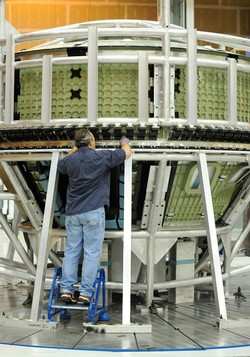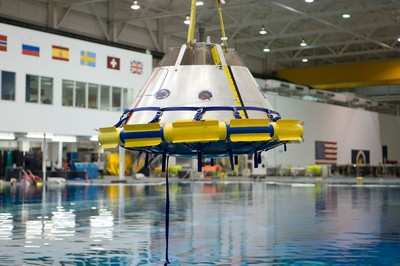Inexpensive, Lightweight, Buoyant ... What's Not To Like?
 If ping-pong balls can float a sunken boat, they should be able
to keep an uncrewed space capsule simulator from sinking.
If ping-pong balls can float a sunken boat, they should be able
to keep an uncrewed space capsule simulator from sinking.
Right?
That's what a team of summer students and engineers think at
NASA's Langley Research Center in Hampton, Va. Langley is
fabricating a proposed design of an astronaut crew module simulator
for uncrewed flight-testing as part of the agency's effort to build
a vehicle to replace the space shuttle. The Orion crew exploration
vehicle is the nation's next generation spacecraft designed to
carry up to four astronauts to low Earth orbit and beyond.
Orion's first suborbital flight test will launch to 400,000
feet, or 75 miles above Earth. Because the crew module will not be
pressurized during the test, it will not have the buoyancy of a
pressurized spacecraft. This puts the simulated crew module at risk
of sinking to the bottom of the Atlantic Ocean after splashdown. To
save the valuable test article for analysis and possible reuse,
Langley called on a team of creative minds for a solution.

Orion Crew Module
And as it turned out, inexpensive, lightweight ping-pong balls
provided the answer. Langley engineer John DiNonno proposed the
idea, and the Orion Flight Test Office told the team to study it.
The idea quickly became "very plausible," said student Caroline
Kirk.
"At first we didn't really realize that we were going to get so
far in proving that it would be possible," said Kirk, a Suffolk,
Va., native attending Virginia Tech as an aerospace engineering
major. "But when we thought about everything logically, it just
seemed like ping-pong balls were the way to go."
She and a team of seven other students worked the project in
Langley's Mechanical Systems Branch, where they were assigned for
the summer. DiNonno got the idea from a Discovery Channel program
about raising a sunken boat using 27,000 ping-pong balls.
Engineer David Covington said that when DiNonno suggested the
ping-pong ball idea, "I just laughed. Not a 'what are you thinking'
kind of laugh, but more of a 'that's the most awesome thing I've
heard in a long time' laugh. I asked him 'are you serious?' and he
said 'yeah, we're authorized to do a four-week study.' So we went
straight to work."

Orion Crew Module NASA Image
Ensuring the outcome would be relatively low-cost was a top
priority, said DiNonno. "Recovering the capsule was not a
requirement, but it was a desire," he said. "So there wasn't going
to be a lot of investment in it."
The students divided the tasks needed to determine if the idea
was feasible, each becoming a "principal investigator" for a
specific area. They tested ping-pong balls of varying quality, much
the way spacecraft hardware is tested. They studied how the balls
would react to the near vacuum at the edge of space. Using buoyancy
tests, they determined how well the balls would float. The students
also subjected the ping-pong balls to mechanical loads using a
hydraulic press, and heated them to see how they would react to the
high temperatures of descent into the Earth's atmosphere. And they
performed electrostatic discharge tests to determine if the balls
would produce a static charge that could disrupt the space
capsule's electronics.

Orion Water Test NASA Image
The ping-pong balls passed all the challenges, said Heather
Blount, a materials science engineering student at Virginia Tech.
"Through all our testing and calculations, we figured out that it
could be a safe and viable option," said Blount.
Keeping the crew module afloat would take at least 150,000
ping-pong balls, the students estimate, at a retail price of 50
cents or less each -- a fraction of the cost of traditional
options. The students hope to reduce the cost through a bulk
purchase. If the flight test is approved, the ping-pong ball
concept will need to be vetted with the flight test team and
reviewed by NASA senior management. If implemented, the ping-pong
balls probably will be put into netted bags and secured inside the
crew module just prior to launch. They would virtually fill the
available space inside the capsule.
Then, when the unsealed capsule splashes down, the buoyancy of
the ping-pong balls will offset the weight of incoming water and it
will float instead of sink. The ping-pong balls also will reduce
the volume of air that needs to be vented from the capsule during
ascent - as well as drawn in during descent - as the capsule
travels through significant changes in atmospheric pressure.

Orion G System Test NASA Image
Approval of the flight test, as well as a launch date, has yet
to be determined. "Even if it is not used, it's an idea that's out
there that someone else could use," said Langley engineer Amanda
Cutright, a student mentor. Cutright said she has been enthused by
the students. "It's awesome working with them," she said. "They
bring a different perspective. I've been really impressed with how
quickly they pick up new ideas and new technology. It seems each
team of students that we mentor learns quicker and is able to
provide creative ideas."
Kirk said the ping-pong ball project has been a unique experience.
At school, she said, "we do lab experiments but nothing similar to
this at all. Being able to develop an experiment that will be used
for space flight tests is an opportunity of a lifetime."
 ANN's Daily Aero-Linx (04.13.24)
ANN's Daily Aero-Linx (04.13.24) ANN's Daily Aero-Term (04.13.24): Beyond Visual Line Of Sight (BVLOS)
ANN's Daily Aero-Term (04.13.24): Beyond Visual Line Of Sight (BVLOS) Airborne 04.09.24: SnF24!, Piper-DeltaHawk!, Fisher Update, Junkers
Airborne 04.09.24: SnF24!, Piper-DeltaHawk!, Fisher Update, Junkers Aero-News: Quote of the Day (04.14.24)
Aero-News: Quote of the Day (04.14.24) ANN's Daily Aero-Term (04.14.24): Maximum Authorized Altitude
ANN's Daily Aero-Term (04.14.24): Maximum Authorized Altitude







